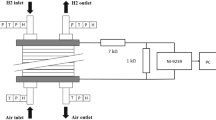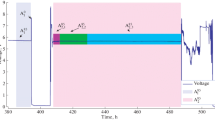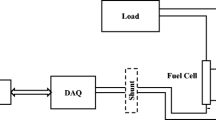Abstract
Electrochemical noise (EN) generated by a PEM fuel cell stack (600 W, 8 cells with surface area 220 cm2) has been measured in well-controlled operational conditions following DOE recommendations for 100 h. For the first time, robust and stable statistical noise descriptors of a PEM fuel cell stack have been obtained based on PSD (power spectral density) spectra in the frequency range of 0.1 Hz < f < 103 Hz. The reference noise signature of the stack involves white noise at the low-frequency range (f < 0.1 Hz), two fractional noises (1/fα) with different slopes, and a pronounced peak at the characteristic frequency f = 1.6 Hz. In the intermediate frequency range (0.1 Hz < f < 1 Hz), the slope α1 = 1.49 and in the high-frequency range (f > 10 Hz), the slop α2 = 3.23. Qualitative interpretations of the obtained noise signature have been proposed. The influence of interruption of stack operation on noise signature has been studied. It was shown that, just after a few hours, other peaks are visible in noise signature at f = 0.004 Hz and f = 0.06 Hz. These peaks disappear after about 20 h; this time can be considered as a characteristic time of relaxation of the slowest processes. It can be also noted that during stack relaxation, the slope in the intermediate frequency range increases and the slope at the high-frequency domain remains constant. It seems that fractional noise at high-frequency range reflects charge transfer processes in catalytic layers with smaller time constants. On the other hand, low and intermediate frequency ranges are related to mass transport and water management processes with higher time constants.











Similar content being viewed by others
Abbreviations
- EN:
-
electrochemical noise
- ENA:
-
electrochemical noise analysis
- PEMFC:
-
proton exchange membrane fuel cell
- MEA:
-
membrane electrode assembly
- PSD:
-
power spectral density
- 1:
-
zone 1 of the campaign measurements
- 2:
-
zone 2 of the campaign measurements
- 2,1:
-
part 1 of zone 2 of the campaign measurements
- 2,2:
-
part 2 of zone 2 of the campaign measurements
- 2,3:
-
part 3 of zone 2 of the campaign measurements
- 85:
-
current of 85A
- α :
-
power factor of fractional noise (PSD linear slope in logarithmic coordinates)
- ƒ :
-
frequency/Hz
- T :
-
time/sec or hour
References
Dicks AL, Rand DAJ (2018) Fuel Cell Systems Explained, 3rd edn. Wiley, Chichester. https://doi.org/10.1002/9781118706992
Wang Y, Chen KS, Mishler J, Cho SC, Adroher XC (2011) A review of polymer electrolyte membrane fuel cells: technology, applications, and needs on fundamental research. Appl Energy 88(4):981–1007. https://doi.org/10.1016/j.apenergy.2010.09.030
Li H, Li H, Tang Y, Wang Z, Shi Z, Wu S et al (2008) A review of water flooding issues in the proton exchange membrane fuel cell. J Power Sources 178(1):103–117. https://doi.org/10.1016/j.jpowsour.2007.12.068
Simons A, Bauer C (2011) Life cycle assessment of hydrogen production. Book Chapter. In: Wokaun A, Wilhelm E (eds) Transition to Hydrogen—Pathways toward Clean Transportation. Cambridge University Press, Cambridge. https://doi.org/10.1017/cbo9781139018036.006
Coutanceau C, Baranton S (2016) Electrochemical conversion of alcohols for hydrogen production: a short overview. WIRE Energy Environ 5(4):388–400. https://doi.org/10.1002/wene.193
Selembo PA, Perez JM, Lloyd WA, Logan BE (2009) High hydrogen production from glycerol or glucose by electro-hydro genesis using microbial electrolysis cells. Int J Hydrog Energy 34(13):5373–5381. https://doi.org/10.1016/j.ijhydene.2009.05.002
Bambagioni V, Bevilacqua M, Bianchini C, Filippi J, Lavacchi A, Marchionni A, Vizza F, Shen PK (2010) Self-sustainable production of hydrogen, chemicals, and energy from renewable alcohols by electrocatalysis. ChemSusChem 3(7):851–855. https://doi.org/10.1002/cssc.201000103
Jiménez-Rodríguez A, Serrano A, Benjumea T, Borja R, El Kaoutit M, Fermoso FG (2019) Decreasing microbial fuel cell start-up time using multi-walled carbon nanotubes. Emerg Sci J 3(2):109–114. https://doi.org/10.28991/esj-2019-01174
Santoro C, Arbizzani C, Erable B, Ieropoulos I (2017) Microbial fuel cells: from fundamentals to applications. A review. J Power Sources 356:225–244. https://doi.org/10.1016/j.jpowsour.2017.03.109
Parsa N, Khajouei G, Masigol M, Hasheminejad H, Moheb A (2018) Application of electrodialysis process for reduction of electrical conductivity and COD of water contaminated by composting leachate. Civil Eng J 4(5):1034–1045. https://doi.org/10.28991/cej-0309154
Ali A, Ejaz N, Nasreen S, Nasir A, Qureshi LA, Al-Sakkaf BM (2019) Enhanced degradation of dyes present in textile effluent by ultrasound-assisted electrochemical reactor. Civil Eng J 5(10):2131–2142. https://doi.org/10.28991/cej-2019-03091399
Ellamla H, Staffell I, Bujlo P, Pollet BG, Pasupathi S (2015) Current status of fuel cell-based combined heat and power systems for the residential sector. J Power Sources 293:312–328. https://doi.org/10.1016/j.jpowsour.2015.05.050
Barbir F (2013) PEM fuel cells, 2nd edn. Academic Press Inc, Cambridge. https://doi.org/10.1016/b978-0-12-387710-9.05002-5
Wu J, Yuan XZ, Martin JJ, Wang H, Zhang J, Shen J, Wu S, Merida W (2008) A review of PEM fuel cell durability: degradation mechanisms and mitigation strategies. J Power Sources 184(1):104–119. https://doi.org/10.1016/j.jpowsour.2008.06.006
Nigmatullin RR, Martemianov S, Evdokimov YK, Denisov E, Thomas A, Adiutantov N (2016) New approach for PEMFC diagnostics based on quantitative description of quasi-periodic oscillations. Int J Hydrog Energy 41(29):12582–12590. https://doi.org/10.1016/j.ijhydene.2016.06.011
Khazaee I, Ghazikhani M, Mohammadiun M (2012) Experimental and thermodynamic investigation of a triangular channel geometry PEM fuel cell at different operating conditions. Sci Iranica 19(3):585–593. https://doi.org/10.1016/j.scient.2011.11.039
Martemianov S, Ilie VR, Coutanceau C (2014) Improvement of the proton exchange membrane fuel cell performances by optimization of the hot pressing process for membrane electrode assembly. J Solid State Electrochem 18(5):1261–1269. https://doi.org/10.1007/s10008-013-2273-2
Grigoriev SA, Fedotov AA, Martemianov SA, Fateev NA (2014) Synthesis of nanostructural electrocatalytic materials on various carbon substrates by ion plasma sputtering of platinum metals. Russ J Electrochem 50(7):638–646. https://doi.org/10.1134/s1023193514070064
Thomas A, Maranzana G, Didierjean S, Dillet J, Lottin O (2013) Measurements of electrode temperatures, heat and water fluxes in PEMFCs: conclusions about transfer mechanisms. J Electrochem Soc 160(2):F191–F204. https://doi.org/10.1149/2.006303jes
Banerjee R, Howe D, Mejia V, Kandlikar SG (2014) Experimental validation of two-phase pressure drop multiplier as a diagnostic tool for characterizing PEM fuel cell performance. Int J Hydrog Energy 39(31):17791–17801. https://doi.org/10.1016/j.ijhydene.2014.08.118
Dib A, Maizia R, Martemianov S, Thomas A (2019) Statistical short time analysis for proton exchange membrane fuel cell diagnostic-application to water management. Fuel Cells 19(5):539–549. https://doi.org/10.1002/fuce.201900060
Astafev EA (2020) Comparison of approaches in electrochemical noise analysis using an air-hydrogen fuel cell. Russ J Electrochem 56(2):156–162. https://doi.org/10.1134/s1023193520020032
Legros B, Thivel PX, Bultel Y, Nogueira RP (2011) First results on PEMFC diagnosis by electrochemical noise. Electrochem Commun 13(12):1514–1516. https://doi.org/10.1016/j.elecom.2011.10.007
Miramontes JA, Nieves-Mendoza D, Castillo-González E, Almeraya-Calderón F (2014) Electrochemical noise analysis of nickel-based superalloys in acid solutions. Int J Electrochem Sci 9(12):523–928. https://doi.org/10.5006/1.3294407
Vorotyntsev MA, Martem’Yanov SA, Grafov BM (1984) Temporal correlation of current pulsations at one or several electrodes: a technique to study hydrodynamic fluctuation characteristics of a turbulent flow. J Electroanal Chem Interfacial Electrochem 179(1-2):1–23. https://doi.org/10.1016/s0022-0728(84)80270-3
Adolphe X, Danaila L, Martemianov S (2007) On the small-scale statistics of turbulent mixing in electrochemical systems. J Electroanal Chem 600(1):119–130. https://doi.org/10.1016/j.jelechem.2006.04.023
Martemianov S, Danaila L (2003) On the study of electrochemical turbulent noise in a stirred vessel. Fluct Noise Lett 3(04):L463–L471. https://doi.org/10.1142/s0219477503001555
Gabrielli C, Huet F, Keddam M (1985) Characterization of electrolytic bubble evolution by spectral analysis. Application to a corroding electrode. J Appl Electrochem 15(4):503–508. https://doi.org/10.1007/bf01059291
Hodgson DR (1996) Application of electrochemical noise and in situ microscopy to the study of bubble evolution on chlorine evolving anodes. Electrochim Acta 41(4):605–609. https://doi.org/10.1016/0013-4686(95)00347-9
Mansfeld F, Lee CC (1997) The frequency dependence of the noise resistance for polymer-coated metals. J Electrochem Soc 144(6):2068–2071. https://doi.org/10.1149/1.1837743
Bertocci U, Frydman J, Gabrielli C, Huet F, Keddam M (1998) Analysis of electrochemical noise by power spectral density applied to corrosion studies maximum entropy method or fast Fourier transform. J Electrochem Soc 145(8):2780–2786. https://doi.org/10.1149/1.1838714
Gabrielli C, Keddam M (1992) Review of applications of impedance and noise analysis to uniform and localized corrosion. Corrosion 48(10):794–811. https://doi.org/10.5006/1.3315878
Gabrielli C, Huet F, Keddam M (1986) Investigation of electrochemical processes by an electrochemical noise analysis. Theoretical and experimental aspects in potentiostatic regime. Electrochim Acta 31(8):1025–1039. https://doi.org/10.1016/0013-4686(86)80018-4
Denisov ES, Evdokimov YK, Martemianov S, Thomas A, Adiutantov N (2016) Electrochemical noise as a diagnostic tool for PEMFC. Fuel Cells 17(2):225–237. https://doi.org/10.1002/fuce.201600077
Astafev EA, Ukshe AE, Gerasimova EV, Dobrovolsky YA, Manzhos RA (2018) Electrochemical noise of a hydrogen-air polymer electrolyte fuel cell operating at different loads. J Solid State Electrochem 22(6):1839–1849. https://doi.org/10.1007/s10008-018-3892-4
Huet F, Nogueira RP, Lailler P, Torcheux L (2006) Investigation of the high-frequency resistance of a lead-acid battery. J Power Sources 158(2):1012–1018. https://doi.org/10.1016/j.jpowsour.2005.11.026
Martemianov S, Adiutantov N, Evdokimov YK, Madier L, Maillard F, Thomas A (2015) New methodology of electrochemical noise analysis and applications for commercial Li-ion batteries. J Solid State Electrochem 19(9):2803–2810. https://doi.org/10.1007/s10008-015-2855-2
Astafev EA (2020) The measurement of electrochemical noise of a Li-ion battery during charge-discharge cycling. Measurement 154:107492. https://doi.org/10.1016/j.measurement.2020.107492
Greisiger H, Schauer T (2000) On the interpretation of the electrochemical noise data for coatings. Prog Org Coat 39(1):31–36. https://doi.org/10.1016/s0300-9440(00)00096-5
Xiao H, Mansfeld F (1994) Evaluation of coating degradation with electrochemical impedance spectroscopy and electrochemical noise analysis. J Electrochem Soc 141(9):2332–2337. https://doi.org/10.1149/1.2055121
Bahrami MJ, Shahidi M, Hosseini SMA (2014) Comparison of electrochemical current noise signals arising from symmetrical and asymmetrical electrodes made of Al alloys at different pH values using statistical and wavelet analysis. Part I: Neutral and acidic solutions. Electrochim Acta 148:127–144. https://doi.org/10.1016/j.electacta.2014.10.031
Aballe A, Bethencourt M, Botana FJ, Marcos M (1999) Using wavelets transform in the analysis of electrochemical noise data. Electrochim Acta 44(26):4805–4816. https://doi.org/10.1016/s0013-4686(99)00222-4
Lentka L, Smulko J (2019) Methods of trend removal in electrochemical noise data – overview. Measurement 131:569–581. https://doi.org/10.1016/j.measurement.2018.08.023
Grafov BM, Dobrovolskij YA, Kluev AL, Ukshe AE, Davydov AD, Astaf’ev EA (2017) Median Chebyshev spectroscopy of electrochemical noise. J Solid State Electrochem 21(3):915–918. https://doi.org/10.1007/s10008-016-3395-0
Martemyanov SA, Petrovskiy NV, Grafov BM (1991) Turbulent pulsations of the microelectrode limiting diffusion current. J Appl Electrochem 21(12):1099–1102. https://doi.org/10.1007/bf01041455
Martemianov S (2017) Statistical theory of turbulent mass transfer in electrochemical systems. Russ J Electrochem 53(10):1076–1086. https://doi.org/10.1134/s1023193517100081
Kay SM, Marple SL (1981) Spectrum analysis—a modern perspective. Proc IEEE 68(11):1380–1419. https://doi.org/10.1109/PROC.1981.12184
Maizia R, Dib A, Thomas A, Martemianov S (2017) Proton exchange membrane fuel cell diagnosis by spectral characterization of the electrochemical noise. J Power Sources 342:553–561. https://doi.org/10.1016/j.jpowsour.2016.12.053
Acknowledgments
The authors are very thankful to Professor Fritz Scholz, founder, and Editor-In-Chief of the Journal of Solid State Electrochemistry, for the interest and support of electrochemical noise diagnostics.
Funding
This work has been supported by the ANR project PROPICE (ANR-12-PRGE-0001) funded by the French National Research Agency.
Author information
Authors and Affiliations
Corresponding author
Additional information
This paper is dedicated to the 65th birthday of Professor Fritz Scholz.
Publisher’s note
Springer Nature remains neutral with regard to jurisdictional claims in published maps and institutional affiliations.
Rights and permissions
About this article
Cite this article
Martemianov, S., Thomas, A., Adiutantov, N. et al. Electrochemical noise analysis of a PEM fuel cell stack under long-time operation: noise signature in the frequency domain. J Solid State Electrochem 24, 3059–3071 (2020). https://doi.org/10.1007/s10008-020-04759-z
Received:
Revised:
Accepted:
Published:
Issue Date:
DOI: https://doi.org/10.1007/s10008-020-04759-z




